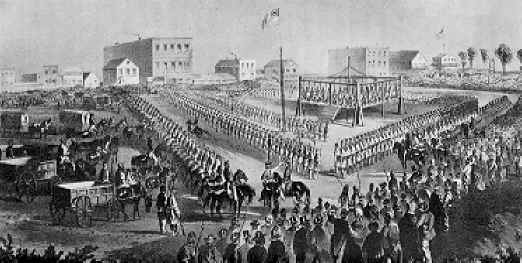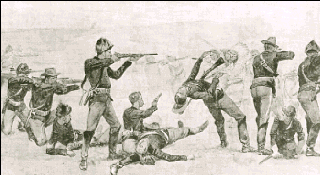|
|
|
The Great Sioux Nation |
| The Sioux nation is said to have had twenty thousand people in it divided among its seven tribes. By dancing and having self-inflicted wounds, you were identified as a warrior. The war path was the right of passage for males. All warriors were honored by their families. Chiefs were voted on by different bands. The title of chief was a title, nothing more. They were considered guides, not commanders. |
|
Beginning of the Great Sioux War |
|
Tensions had been building between Native Americans and the white man for years. Finally in 1854, a small band of Sioux killed 19 soldiers near Fort Laramie. The United States retaliated by killing one hundred Sioux and imprisoning their chief in Nebraska. |
|
Santee War- Homestead Act |
| On December 26, 1862, 38 innocent Sioux were
killed due to the Homestead Act. The original number of Indians
who were supposed to be hung was 303, but President Lincoln reduced the number to forty. One
Sioux was removed from the list for testifying against his own tribe, and
another was removed for saving a white woman's life.
Thirty-eight innocent Sioux were hung due to the Homestead Act of 1862.
|
|
Fetterman Massacre (Battle of One Hundred Slain) |
| Crazy Horse and many of his followers lured some soldiers out of their fort and killed them on December 21,1866. Weeks later a plan was set into action to ambush, trap, and kill United States troops. Two thousand warriors set up camp two miles north of the trap. Ten young warriors were selected from each tribe to execute the most dangerous maneuvers of the trap. One the day of the massacre, the warriors finally got all the soldiers in the spot they were hoping for. Hidden warriors rose up from unknown spots. They were successful. All eighty of the soldiers were killed. But they weren't totally successful. Since the Indians were poorly armed, many were killed. The massacre is named after Captain Fetterman, the man who was in charge of the soldiers. The Indians gave their own name to the Fetterman Massacre- Battle of One Hundred Slain. |
| In the fall of 1865, the Sioux signed nine treaties, but
none of chiefs who signed them were war chiefs. At the beginning
of the year 1876, the Government gave the Sioux an ultimatum. It
was one that said that any Sioux that didn't report to the Great Sioux
Reservation by January 31 was considered hostile. Unfortunately,
many Indians didn't hear about this until after the deadline. On March
17, 1876, General Crook attacked a Cheyenne and Sioux camp on the Powder
River. The Indians were driven from their lodges, and many were
killed. Their lodges and winter supplies were burned.
General Crook and his men also stole the Indians' horse herd.
However, the Indians recaptured them during the night.
|
|
Custer's Last Stand Little Bighorn (Custer's Last Stand) |
| General George Armstrong Custer and the 7th Calvary left their camp on the Rosebud River on June 22, 1876, hoping to have an easy defeat over the Indians. Custer and five companies attacked 40 warriors at Sitting Bull's main camp. The warriors looked live they were retrieving. Major Reno attacked the other side of the village with seven companies. The white man had underestimated the Sioux and Cheyenne. Custer was attacking what he thought was the end of the village, but it was really the middle. The village was believed to be three miles long and a half a mile wide, but it was really seven miles long. Along with that mistake came another. There were three times as many warriors in that village as in the whole 7th Calvary. Reno's squadron of 175 men were surrounded in an indefensible position. The Indians gained higher ground and held them there for a day until Gibbon's command came. Sitting Bull's entire force was 4000 strong. No matter how hard Custer and his men fought, they would lose. All 207 men of the 7th Calvary were killed. The Cheyenne and Sioux abandoned their village after mutilating the dead soldiers. |
|
Massacre at Wounded Knee |
| The strategy for the U.S. soldiers was to capture Sitting Bull and the Standing Rock Reservation. The Standing Rock Reservation was captured by U.S. troops in December of 1890. Sitting Bull was killed on the December 15. Big Foot was trying to lead 350 of his people to the Pine Ridge Reservation. Troops had them surrounded the whole way. On the December 29, as they were all camping by Wounded Knee Creek, an accidental gunshot was fired. Hotchkiss guns were aimed at teepees, and many ran for their lives. The Indians tried running away, but they were cut off. Three hundred Indians were killed including Big Foot. Twenty-five soldiers were also killed. |
|
The artist drew this painted from soldiers reliving the Massacre at Wounded Knee.
|


